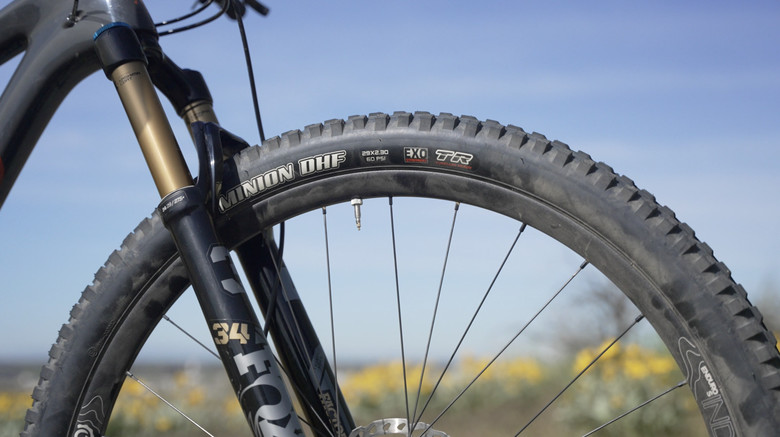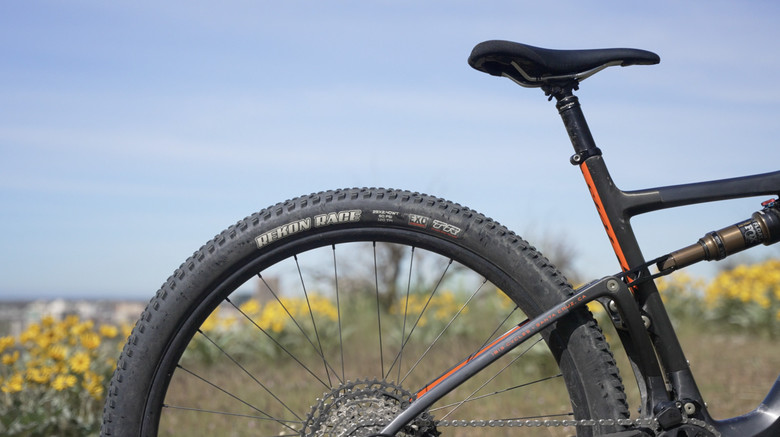Why Do an Efficiency Test?
Our Short Travel Test Session included four bikes that all prioritized speed and efficiency: Alchemy’s Arktos 120, Scott’s Spark 910, Ibis’s Exie, and YT’S IZZO. As most riders can relate, speed comes at a lower price once gravity takes over, while efficiency is crucial to transferring rider output into forward momentum on climbs.

Driven mostly by curiosity to see if our on-trail impressions would align with the clock, we set out to see which bike was the fastest going uphill. Many factors, such as tire choice, suspension design, and geometry, affect how quickly and efficiently a bike climbs. To level the playing field (at least a little bit), Vital Editor Jason Schroeder stepped up to the plate equipped with a set of SRM X-Power pedals to lay down an equal effort on all four bikes.
Before you read further, let us clarify that this was not a highly scientific test performed in a vacuum. Our goal was to see what we could conclude about climbing performance by comparing similar bikes with slight variations in components and intended use. And to have some fun with some neat bikes and fancy pedals.
Testing Parameters
For the test, we created a Strava segment up a smooth, mile-long dirt road with an average grade of 6.8% and 98 feet (29.8 meters) of elevation gain. We chose dirt over pavement simply because we were testing mountain bikes and wanted to see how each bike would perform in a realistic situation where small bumps and a need for traction existed.

We completed the climb on each bike twice, once with the suspension open and again with any suspension lockouts engaged. The Alchemy Arktos 120 and YT IZZO featured only an external compression lockout switch on the rear shock, while the Ibis Exie and Scott Spark used lever-actuated full-suspension lockouts. We also set tire pressure the same for all bikes.
Isolating Rider Input
To ensure we laid down equal effort on each bike, we used a set of SRM Power Meter pedals. SRM is renowned for its class-leading power meter products, and the X-Power pedals are their rugged mountain bike offering. Using a standard SPD mechanism, the pedals are accurate within 2% and compatible with ANT+, Bluetooth, and Zwift. SRM also has its own app, which simplifies calibration and provides live power outputs.

We used the dual meter version to view our power output for each leg. With the X-Power pedals connected and our Garmin conveniently mounted on our handlebar, we shot to maintain an average of 280 watts climbing.
Why We Did Not Use Control Tires
A debated topic, we could have used the same tires on all bikes. However, tire choice significantly affects how a bike performs, and each brand clearly picked tires that they believed matched their bike’s intended use and abilities. For example, the Ibis Exie used Maxxis’ Rekon Race tires that offered minimal rolling resistance and added to its climbing prowess. However, the tires lacked traction and limited the Exie’s speed descending. Adversely, the Artos 120 used a Maxxis Minion DHF and DHR II tire combo that, theoretically, rolled slower than the Rekon Race tires but provided gobs more traction and grip to match the descent-focused ability of the bike. All of this is to say that had the Artos 120 come with Rekon Race tires or the Exie showed up with a meaty DHF front tire, it would have not matched the overall build and abilities of the bike. We also wanted our efficiency test to reflect how riders will receive each bike and how we rode them during testing.


The Exie, IZZO, and Arktos used Maxxis tires with their XC-focused EXO casing, while the Spark uses Schwalbe’s lightweight Speed Race casing. From lightest to heaviest rolling weight, the breakdown goes Exie, Spark, IZZO, and Arktos. Between the Exie and Arktos, there was a 260-gram difference in tire weight and a 340-gram difference in total rolling weight.
Tires | Wheels | Total Rolling Weight | |
Ibis Exie | 1520g | 1820g | 3340g |
Scott Spark 910 | 1630g | 1840g | 3470g |
YT IZZO | 1470g | 2015g | 3485g |
Alchemy Arktos 120 | 1780g | 1900g | 3680g |
*weights are approximated based on manufacturer claimed weight
Results
Open | Closed |
1st Ibis Exie - 2:19 2nd Alchemy Arktos 120 - 2:25 3rd Scott Spark 910 - 2:26 4th YT IZZO - 2:34 | 1st YT IZZO - 2:22 2nd Scott Spark 910 - 2:24 3rd Ibis Exie - 2:26 4th Alchemy Arktos 120 - 2:27 |

The biggest takeaway from our efficiency test was how much suspension design and compression lockouts dictate climbing performance. Even though the Exie and IZZO were the fastest, there was no clear winner in the group, and it’s tough to link any result to tire spec or weight. Based on the outcome, the bikes can be split into two groups: designs that rely on suspension lockouts to be efficient and those that don’t.

We had an inclination that the Exie and Arktos 120 would perform better without any suspension adjustments. Although very contrasting bikes with different components, geometry, and strong suites, both offered firm, and efficient pedaling platforms. However, we did not expect the Exie to be seven seconds slower when we engaged the dual-suspension lockout. When locked out, the Exie’s suspension became motionless, making it tough to maintain smooth pedal strokes without bouncing around in the saddle. Best saved for roads or smooth trails, we see riders spending the most time climbing the Exie open to help glide over trail vibrations and maintain efficiency. The Arktos, on the other hand, was firmer with the climb switch engaged on the DHX2 shock but still offered some suspension movement, similar to how the Exie felt when open. Against the clock, the Arktos was only two seconds slower with the shock ‘closed.’ After having difficulty feeling a difference in pedaling performance with the climb switch on or off during testing, the results further illustrate how the Arktos is an impressively efficient bike all by itself.
It didn’t take many riders to realize the IZZO and Spark benefited from suspension lockouts to limit pedal-induced suspension movement. However, the Spark’s TwinLoc system in the Lock mode was almost motionless, and efficiency faded when the road became rougher. The Spark was still two seconds faster when ‘closed,’ but the marginal gain shows how the Spark’s lockout was less impactful than the IZZO’s.

The most surprising result was how much faster the IZZO was with the compression switch engaged on its Float DPS shock, going 12-seconds faster than its ‘open’ time and almost besting the Exie’s fastest time of the day. Throughout testing, the IZZO was the least impressive climber compared to the other bikes. With an upright and relaxed pedaling position, the IZZO felt like a trail bike and mentally made us less eager to attack climbs. But once put to the clock, the relaxed body positioning did not limit power transfer. When locked out, the IZZO offered a few millimeters of rear shock movement, providing increased comfort and traction. The silver lining is that the upside-down mounted shock conveniently placed the lockout switch low and out of reach for mid-climb engagement. Knowing how transformed the IZZO’s climbing performance was from the modest rear shock compression switch, we can only assume the IZZO Uncaged 7 model, with 100mm travel and lever-actuated dual-suspension lockouts, would give all the bikes a run for their money.
Let us know what you think of the results below and which bike you’d be most interested in piloting up some big climbs. And please refrain from letting us know how we should have conducted the test; it’s already over.







View replies to: Are Suspension Lockouts Faster for Climbing? - Vital’s Short Travel Efficiency Test
Comments